Explanatory Notes Data on births presented in this release were obtained from the timely and late registered births at the Office of the City/Municipal Civil Registrars all throughout the country and submitted to the Office of the Civil Registrar General through the Philippine Statistics Authority (PSA) - Provincial Statistical Offices (PSOs). The information presented includes births that occurred from January to December 2023 based on data files received by the PSA - Civil Registration Service (CRS) from the PSOs. Figures presented herein are not adjusted for under registration. This release includes births of Filipinos whose usual residence is abroad and births of foreign nationals that occurred in the country during the reference period. Births of Filipinos abroad which were reported to the Philippine Foreign Service Posts are presented in a separate report. |
Regional crude birth rate posted at thirteen births per thousand population
In 2023, the MIMAROPA Region registered a total of 43,287 live births, which accounts to 3.0 percent of the total number of live births registered in the country. During this year, there was a daily occurrence of 119 births were born daily or about five (5) babies born per hour. (Figure 1)
In the past ten years, the region’s annual number of registered live births went down by 9.5 percent from 47,854 in 2014 to 43,287 in 2023. Meanwhile, a 5.2 percent increase was observed in 2023 compared to the 41,158 registered live births in 2022. (Figure 1)
The crude birth rate (CBR) in the region’s was registered at 13 births per thousand population . Variations in CBR was noted across provinces and highly urbanized city, with City of Puerto Princesa as the highest CBR at 15 births per thousand population and Marinduque as the lowest in CBR at 11 births per thousand population. (Table A)

More males were born than females
In 2023, a total of 22,559 males (52.1% share) and 20,728 females (47.9% share) were born in the region. This results in a sex ratio at birth of 109 males per 100 females. (Figure 2 and Table A)

Highest occurrence of births recorded in Oriental Mindoro
Provinces with larger populations reported the highest number of registered live births. Oriental Mindoro recorded the highest number of birth occurrences at 12,735 with a corresponding share of 29.4 percent to the regional total live births registered in 2023. This was followed by Palawan (excluding the City of Puerto Princesa) at 12,044 total registered live births (27.8% share). Meanwhile, Marinduque had the lowest number of registered live births among provinces at 2,788 (6.4% share). On the other hand, City of Puerto Princesa, the region’s lone highly urbanized city, recorded a total number of 4,413 registered live births that corresponds to 10.2 percent of the regional total. (Figure 3 and Table A)
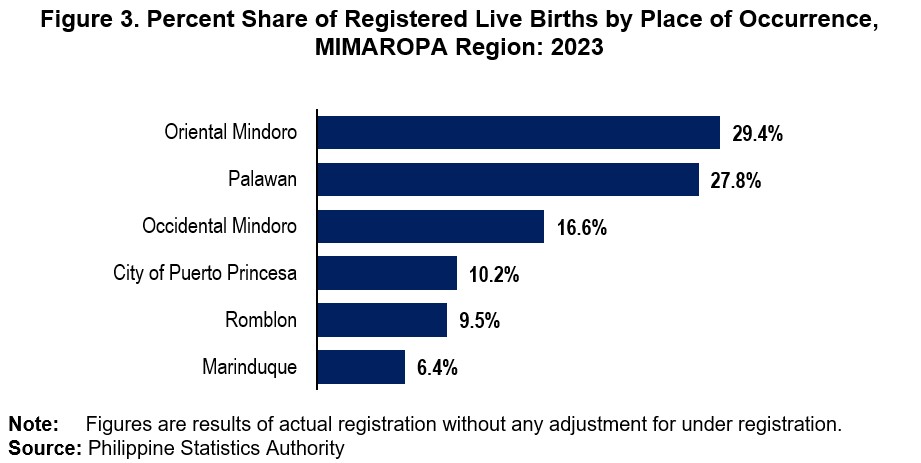
Most number of births was registered in September
In 2023, most registered births occurred in September with 4,062 births, accounting for 9.4 percent of the total regionwide. It was followed by the months of January with 9.3 percent and October with 9.2 percent of the regional total registered live births. On the other hand, the month of June had the least number of live births contributing only 7.5 percent to the regional total. (Figure 4 and Table B)
Eight out of nine birth deliveries were medically attended
Of the total number of registered live births in the region, 87.9 percent were attended by health professionals, such as physicians, midwives, or nurses. Physicians attended the majority of these births, accounting for 67.0 percent, followed by midwives with 19.7 percent and nurses with 1.2 percent. On the other hand, 10.5 percent of the regional total number of live births were delivered by a hilot or traditional birth attendants. (Figure 5)
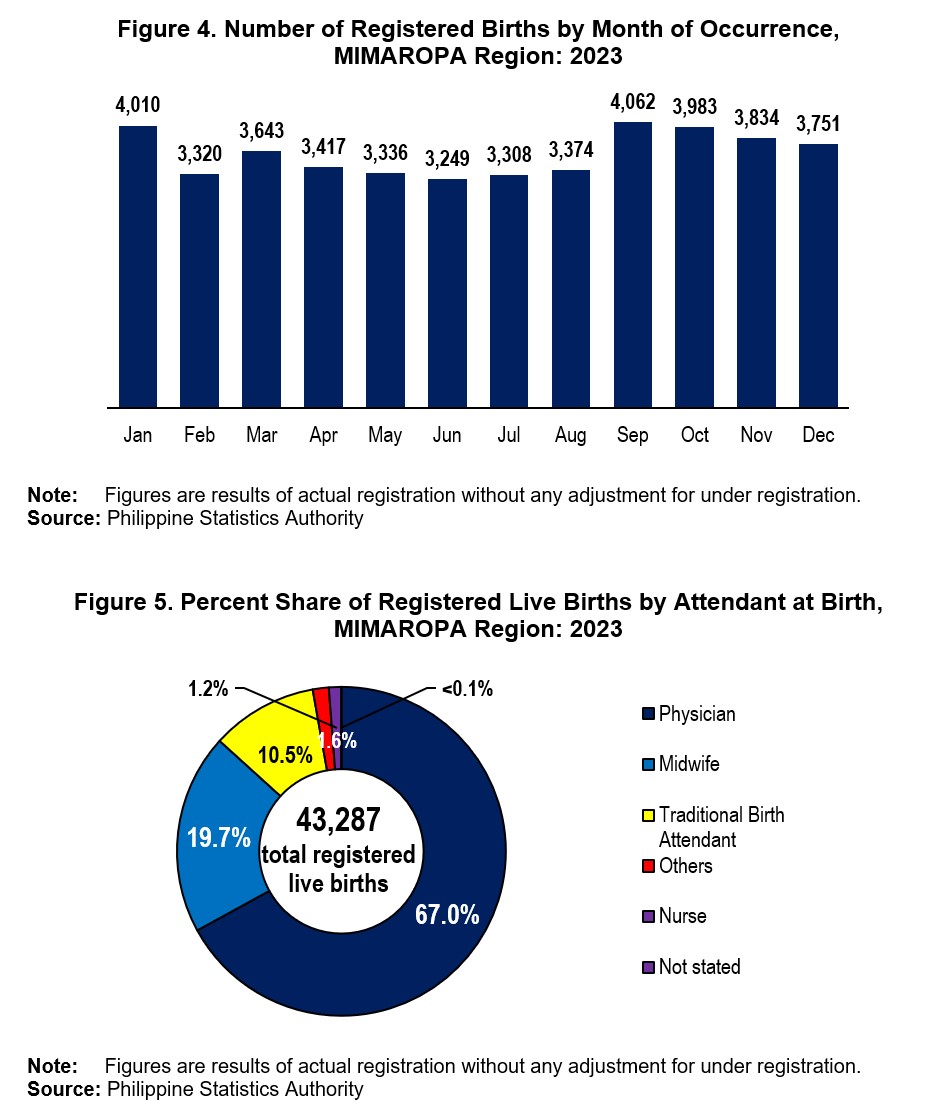
All five provinces and highly urbanized city in the region reported a notable proportion of live births by place of occurrence, attended by health professionals, reflecting improvements in maternal and child health care services. Three provinces and one highly urbanized city had medically attended births exceeding 90.0 percent, and these are City of Puerto Princesa (98.6%), Romblon (97.7%), Marinduque (97.7%), and Oriental Mindoro (90.0%). (Table C)
In addition, 87.6 percent or seven out of eight births in Occidental Mindoro were medically attended. Meanwhile, 76.4 percent or three in every four registered live births occurred in 23 municipalities of Palawan were medically attended by health professionals, while the rest were attended by traditional birth attendants such as hilot or unlicensed midwives, or other type of attendants. (Table C)
Proportion of births delivered in health facilities reached 86.3 percent
In 2023, a total of 37,361 births in the MIMAROPA Region occurred in health facilities such as hospital, birthing clinic, lying in centers, outpatient care center, specialized care center, or similar facilities. This comprises 86.3 percent of the region’s total number of live births. Only 12.1 percent of total births were delivered at home and a meager 1.6 percent were delivered in other locations. (Figure 6 and Table D)
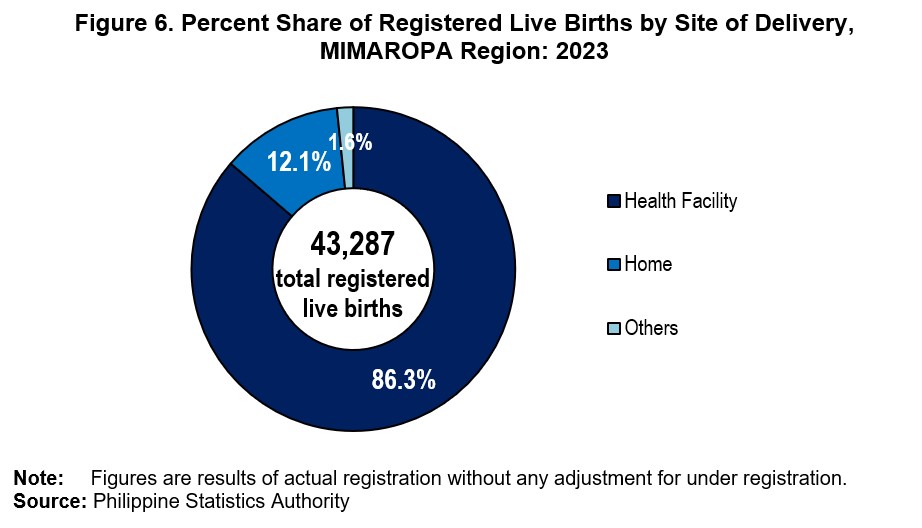
Seventeen in 20 newborn babies weighed at least 2,500 grams
Birth weight serves as a measure of the nutritional status of newborns. Low birth weight is defined by the World Health Organization (WHO) as weight at birth less than 2,500 grams (5.5 lbs.). In 2023, of the total number of newborn babies, 84.9 percent weighted above the low birth weight threshold. Moreover, the median birth weight was 2,908 grams, indicating that half of the newborn babies born in the region weighed at least 2,908 grams. (Figure 7 and Table E)
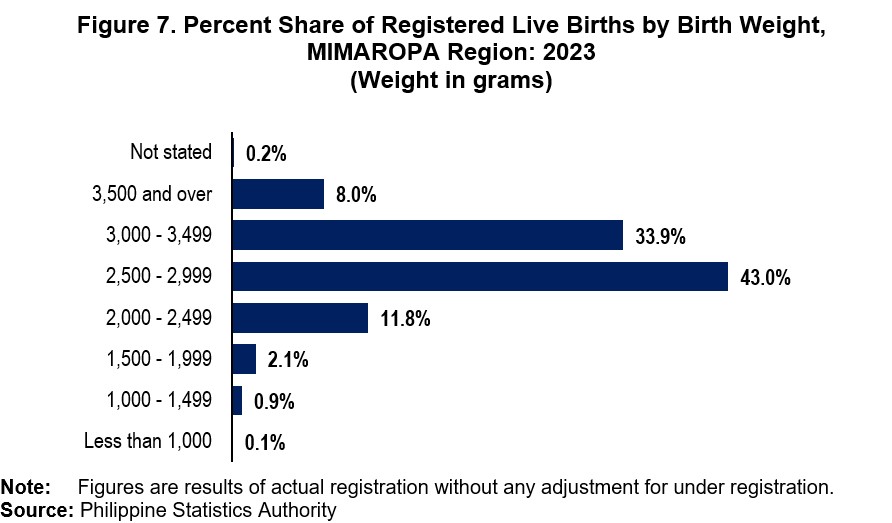
Further, less than 11 in every 25 babies or 43.0 percent weighed between 2,500 to 2,999 grams. This was followed by more than one in every three babies or 33.9 percent weighed between 3,000 to 3,499 grams. Meanwhile nearly one in 1,000 babies, representing 0.1 percent, were born weighing less than 1,000 grams. (Figure 7 and Table E)
Two out of seven babies were born to mothers aged 25-29 years old
In 2023, the age group of 25 to 29 years had the highest representation among parents’ age, with 11,898 live births (27.5%) for mothers and 10,904 live births (25.2%) for fathers. However, babies born to adolescent mothers or those younger than 20 years old recorded 4,747 live births or 11.0 percent, nearly three times the 1,688 live births (3.9%) sired by adolescent fathers. (Figure 8 and Table F)
The median age of mothers at childbirth was 27.8 years old, while the median age of fathers at childbirth was 30.6 years old. This means that half of the births in 2023 were to mothers and fathers who were at least 28 years old and 31 years old, respectively. (Table F)
Eleven in 20 babies were born to unwed mothers
In 2023, at total of 23,702 registered live births were born to unmarried parents in the MIMAROPA Region. This comprised 54.8 percent of the regional total registered live births. Among provinces, Oriental Mindoro posted the highest number of non-marital births based on place of occurrence which accounts to a 17.2 percent share to the regional total non-marital live births. Palawan and Occidental Mindoro followed with 12.7 percent and 9.3 percent share, respectively. (Figure 9 and Table G)

In terms of the proportion of non-marital births by province of occurrence, Romblon was the highest at 65.4 percent. This was followed by Oriental Mindoro (58.3%) and Marinduque (58.0%). In contrast, Palawan recorded the highest proportion of marital births at 54.2 percent. (Figure 9 and Table G)
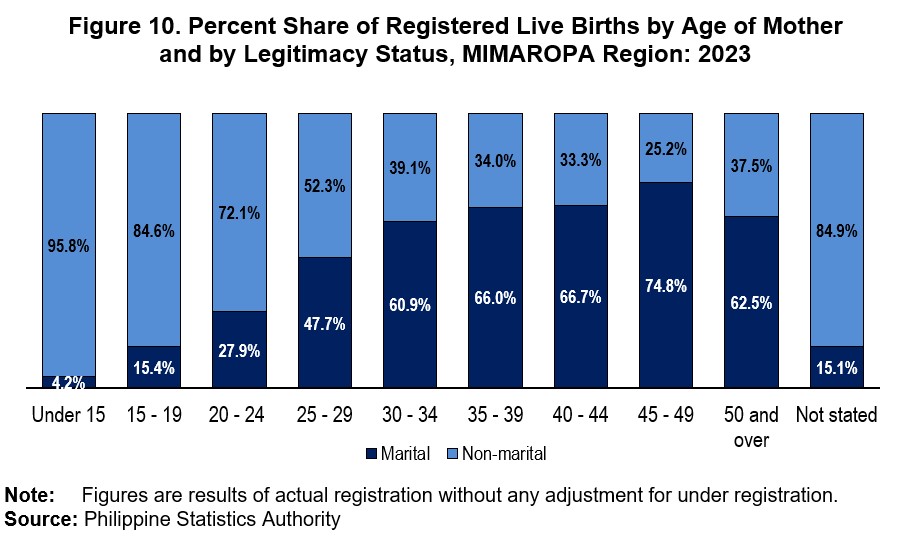
Mothers aged 20 to 24 years had the highest number of non-marital births in 2023, contributing 7,316 or 30.9 percent of the regional total non-marital births. This was followed by mothers aged 25 to 29 years who contributed 6,228 or 26.3 percent of the regional total non-marital births. (Table G)
Adolescent mothers, particularly those under 15 years old, recorded the highest proportion of non-marital births, with 95.8 percent of their total births classified as non-marital. This was followed by aged 15 to 19 years at 84.6 percent and mothers aged 20 to 24 years at 72.0 percent. On the other hand, the lowest proportion of non-marital births at 25.2 percent were among mothers aged 45 years and over. (Figure 10 and
Table G)
Proportion of live births registered on time reached 86.6 percent
In 2023, more than 17 in every 20 live births or 86.6 percent were registered timely, which refers to registration of a birth within 30 days of its occurrence. Three out of five provinces had at least 90.0 percent of their births registered within the required period. Romblon was the highest at 94.2 percent and was followed by Oriental Mindoro and Marinduque at 92.7 percent and 91.5 percent, respectively. On the other hand, the City of Puerto Princesa recorded the highest proportion of late registered births at 35.0 percent, followed by Palawan at 17.6 percent. (Figure 11 and Table H)
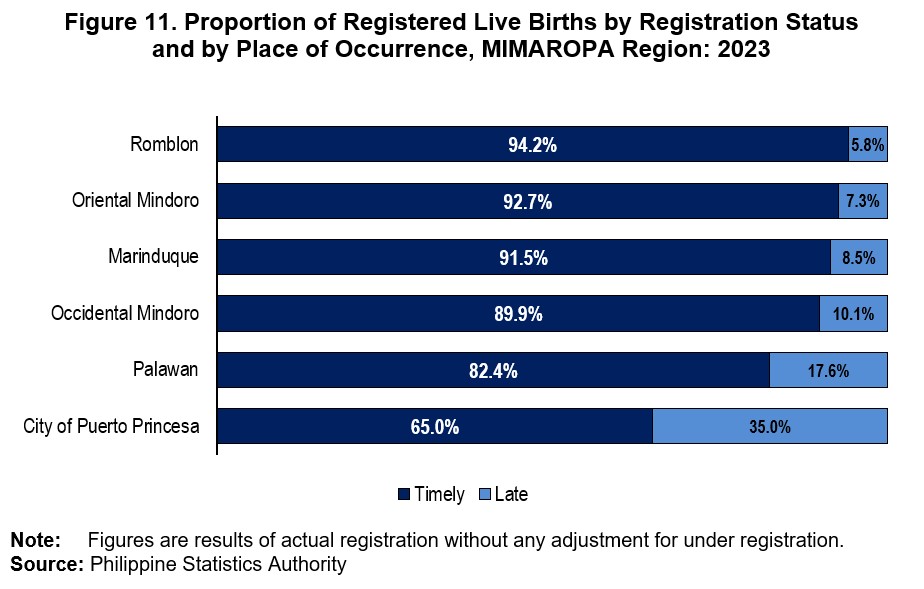
In terms of number of timely registered live births by place of occurrence, Oriental Mindoro was the highest with 11,806 live births or 31.5 percent of the regional total live births that are timely registered. This was followed by Palawan (26.5% share) and Occidental Mindoro (17.2% share). Meanwhile, Marinduque was the lowest with
2,551 live births (6.8% share). (Table H)
On the other hand, Palawan was the highest in terms of the number of late registered live births among provinces and highly urbanized city in the region with 36.5 percent to the region’s 5,799 live births registered beyond 30 days of its occurrence. City of Puerto Princesa and Oriental Mindoro followed with 26.7 percent and 16.0 percent share, respectively. Marinduque had the lowest share with 4.1 percent. (Table H)
(SGD) LENI R. RIOFLORIDO
Regional Director
MLLM / VFM / RRL

